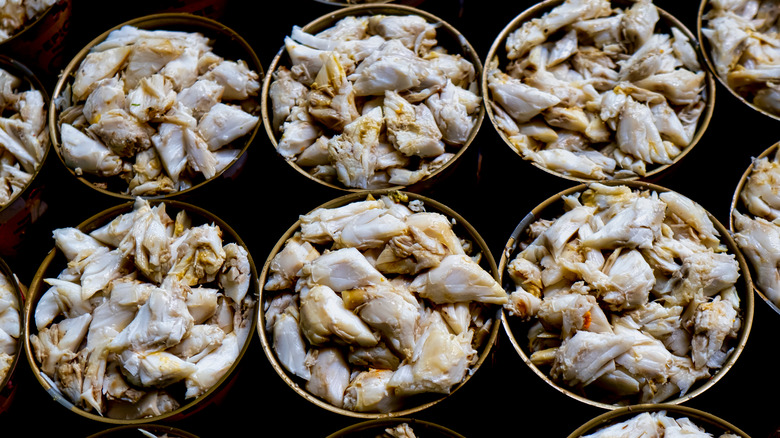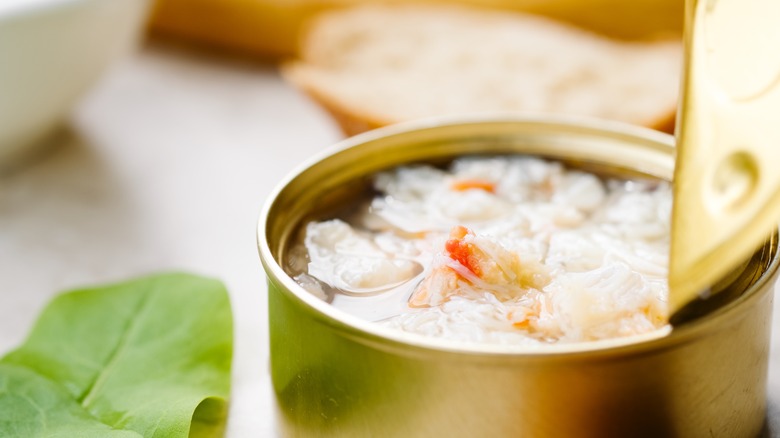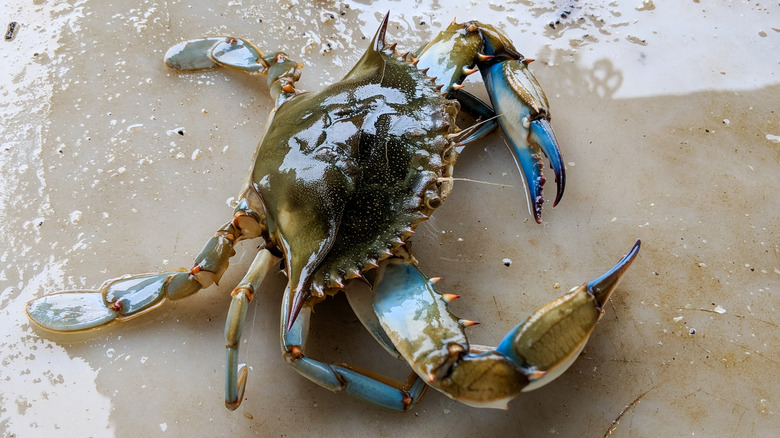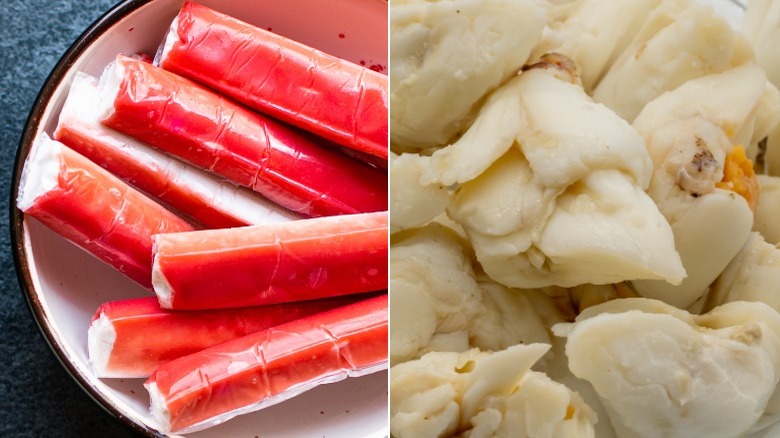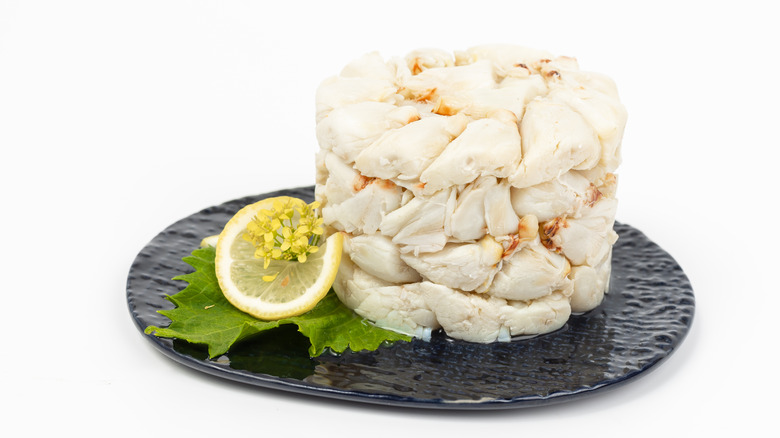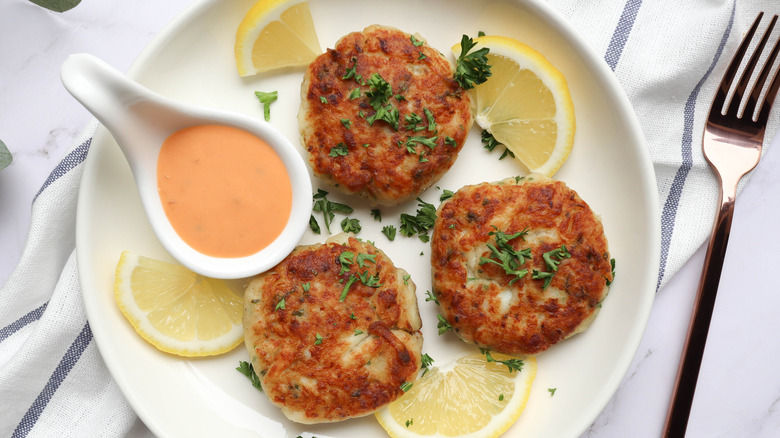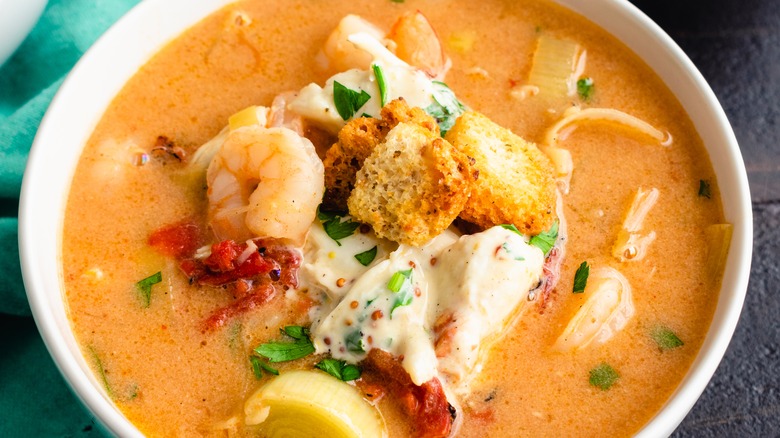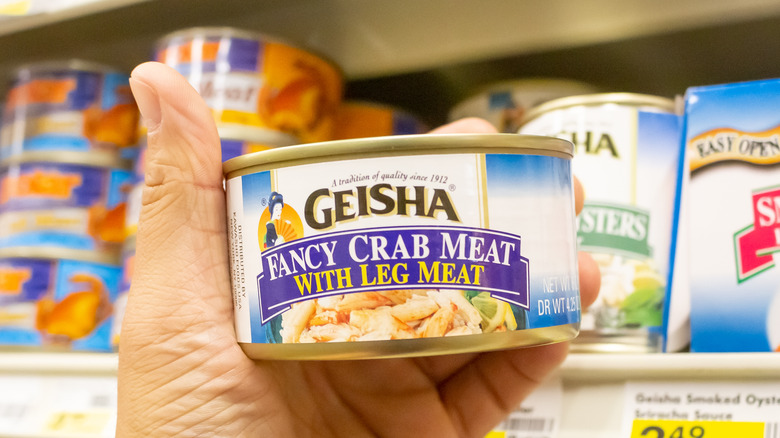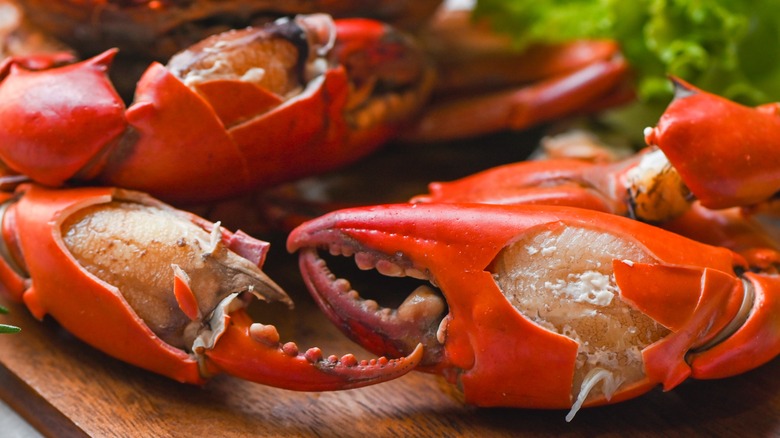What Is Canned Crab And How Is It Best Used?
Walking down the canned goods aisle of the average grocery store is one of the marvels of the modern food system. In one place, you can find shelves filled with an assortment of vegetables, condiments, beans, meat, and fish. The amount — and variety — found in the canned fish area alone is truly astounding. In one, small section of shelves, you have tuna, salmon, trout (sometimes), sardines, anchovies, clams, and crab. And while most of us will just instinctively reach for the ever-recognizable cans of tuna, it would be well worth our time to give some of the other fish a chance. Especially canned crab.
Based solely on outward appearance, crabs (Brachyura) do not look as though they would make appetizing eating. Their long spidery legs, beady little eyes, and large, powerful claws are all deterrents against messing with these temperamental crustaceans. Anyone who has ever accidentally stepped on one while wading in the shallows will understand this perfectly. Crabs do, however, make for extraordinarily good eating, even when canned.
In the United States, we have long and abundant coastlines teaming with countless fish and crustaceans. The cuisines of the states along these coastlines are directly influenced by the native sea creatures caught in the waters. Crabs have been caught and enjoyed by Americans for centuries. And while crab is a global commodity, it seems fitting that the descendants of an American tradition should try their hand at a meal or two with canned crab meat.
What is canned crab meat?
Crab was first canned in the United States near the end of the 19th century. It was not considered a particularly important domestic industry owing to the labor intensive methods of processing the crab meat, plus the problem of discoloration in the meat. The latter issue would eventually be solved thanks to the pasteurization process and the availability of color elongating preservatives. By the 1930s, however, facing significant competition from cheaper, imported options from Japan, the crab canning industry on the Pacific Coast saw significant increases in production before the onset of the second World War. Owing to advanced processing technologies, the way crabs were canned became easier and more efficient.
While domestic stocks of crab have seen a shortage over the last few years, owing chiefly to the availability of labor, the majority of the canned crab market is made up of imported crab from Asia. As fishing is a global industry, we often need to look past our own shores to continue to meet the demands of the market. In spite of the shortages, however, canned fish has seen a recent market upswing. It's not known what percentage of this popularity has graced canned crab meat, but the renewed interested in tinned fish is a market trend that seems to be on the rise owing to the affordability and long shelf life of the products.
How crab gets canned
All quality crab meat should be from crabs that have been canned within days of being caught. They are steamed immediately upon entering the facility. Once they're cooked, the shells get removed and the meat is removed by hand and inspected for quality and size. The meat is then chilled and pasteurized with a combination of salts and certain citric acids, before being vacuum sealed into metal cans.
The meat of the crab is split into a couple different categories. The most common are jumbo lump, lump, backfin, and claw. Like chicken, crab has both white and dark meat. Jumbo lump, lump, and backfin are examples of white meat that comes from the main body of the crab, as well as the connective tissue found at the legs. The claws, being the most active muscles of the crab, are fattier, contain more oil, and have a pinker hue than the white meat. Continuing with the chicken analogy, the white meat of the crab tends to be more tender and mild in flavor, while the dark meat is far stronger and more concentrated.
As with other canned meats and fish, all of these parts of the crab can be canned individually or mixed, and are used for several different purposes, which we'll get into. Backfin, thanks to its flaky texture, is easiest to can and is typically paired with leg meat, which is also tender and flaky.
Canned crab vs imitation crab
There is a popular alternative to crab meat on the market called imitation crab. Yes, that's its actual name. A processed amalgamation of white fish and various other ingredients, imitation crab (aka crab stick) is specifically designed to mimic the taste of real crab meat. But where did it come from?
The concept stretches back several centuries to Japan. Surumi was a paste of chopped white fish, combined with other preservatives designed to increase shelf life. It serves as the base for what we know as imitation crab, which itself is a paste of pollock, tilapia, or cod, mashed together with egg whites, starches, salt, sugar, and, more recently, artificial colors and sweeteners. Popular in the States since the 1970s, the resulting product comes in the form of long sticks with a pearl white interior and bright red exterior. Imitation crab is a key ingredient for California rolls.
The continued popularity of imitation crab is due mainly to the fact that it is a low cost, readily available alternative to the real deal. However, those familiar with the taste of actual crab, the salty tang of imitation crab is immediately noticeable. It doesn't have the sweet, fresh taste of real crab, and is often loaded with MSG to preserve shelf life and stabilize the color. Besides California Rolls, imitation crab is a common addition to crab rangoon, seafood salads, and imitation Crab Cakes.
What does canned crab taste like?
Like its counterpart, canned tuna, the flavor is similar across the spectrum of crabs, regardless of what species is being canned. The flavor difference lies in what kind of meat you buy. As stated earlier, crab has both white and dark meat. Jumbo lumps, the largest cut available, are beautiful chunks of white meat that have a very meaty, tender, sweet taste to them. Lump crab meat is much the same, as it is just the jumbo chunks cut up into slightly smaller pieces. Backfin, the last category of white meat, is very light, flaky, and by far the easiest to can and handle. The dark meat of the crab comes exclusively from the claw, which has a heavy, concentrated crab flavor.
The can you buy will often indicate if it contains a mix. This most often is a cross between different white meats. Claw meat is always canned on its own because of the strength of its flavor.
Most canned crab you get is going to have a saltier, more acidic flavor than fresh crab owing to the fact that a good many canned options have been pasteurized and may contain preservatives. This does not take away from the overall sweetness of the crab, but some brands do offer their wild caught, cooked meat canned in water without added preservatives. These tend to have a milder, fresher taste much closer to that of a fresh caught, steamed crab.
Cooking with crab: crab cakes
We'd be remiss in our discussion of crab meat if we didn't dedicate some space to crab cakes. These delightful patties have been a staple of U.S. cuisine for centuries. It is believed that Native Americans of the Chesapeake Bay area were the first to make crab cakes. It is also believed that crab cakes were one of the first recipes to be shared by the Natives with the arriving colonists.
Maryland boasts some of the best crab cakes in the nation, using fresh lump meat from the native blue crabs. However, as not everyone has such easy access to fresh crabs, canned crab meat will more than suffice for at-home crab cakes. This'll sound like heresy to some, but we can live with that.
After you drain and dry your crab meat, season, and use egg, flour or cornmeal to bind it together and form into patties. Use some Old Bay for that Maryland taste, otherwise use a mix of green bell peppers, zucchini, salt, black pepper, or whatever other seasonings you think will work well. If you're interested in replicating certain styles, Pennsylvania crab cakes usually come with a side of heavy cream sauce. Western-style crab cakes use bread crumbs or crushed crackers as binders. Honestly, the choice is really up to you. Just be sure not to feel too swayed or pressured to use fresh crab for these. Canned crab is perfectly sufficient.
Other ways of cooking with crab
Of course you needn't limit yourself to just crab cakes. There is a veritable ocean of possibilities when it comes to using canned crab in cooking, just as it is with other canned fish. One of the best things about canned crab is that the difficult work has been done for you. Where you'd need to dismember and pull the meat out of a freshly cooked crab, all you need to do with canned crab is drain whatever liquid the meat is stored in and you're good to go!
If you've got claw meat, use it in a bisque or seafood stew. Since the claw meat is the most strongly flavored of all the parts of the crab, it will stand up best to the heavy, creamy flavors present in a good bisque. The white meat is ideal for crab salads or salsas paired with tomatoes, avocado, or mango. You can mix crab into a pasta salad with cucumbers, vinegar, and red onion. You can even try your hand at Crab imperial, a classic Maryland/Virginia casserole of crab topped with parmesan cheese and baked.
You could also make a crab dip by mixing the lump crab meat with cream cheese and some choice herbs. It would make a great appetizer or light lunch paired with a glass of chilled white wine. Sprinkling some cold crab meat over a nice green salad with a few croutons and a light vinaigrette would also be lovely.
Where to buy canned crab
Unlike other highly specific or specialty ingredients, you don't need to go far to find good quality canned crab meat. Any decent grocery store should have some stocked in the canned foods aisle. Well known brands like Bumblebee, Chicken of the Sea, Geisha, and Crown Prince have canned crab meat offerings that are very much the real deal. There is also the possibility that the fish counter at the grocery store has containers of fresh crab meat. You can ask to see if they've had a catch in and are in the process of putting some fresh meat in containers. The option is more available should you live on the coast or have a local fishmonger/seafood market.
These days there is also the ability to purchase online from reputable, small or large scale independent high-quality canning companies. North Coast Sea Foods offers several different varieties of canned crab such as claw, special, lump, super lump, jumbo, and colossal crab. They source their seafood sustainably from locations across the world and back that up with a standard for premium quality. You can also find most, if not all, of the previous brands listed on Amazon.
You could also, if you're the type of person who has an appetite for self reliance, can your own crab meat. This option is really only available to those who live close to coastlines, and have a passion for canning their own food. However, it's probably easier to buy the crab already in cans.
Nutritional information
Like other shellfish and seafood, crab meat is an excellent source of lean protein. For example, one can of Geisha Fancy Crab Meat with Leg Meat contains 16 grams of protein, 473 milligrams of calcium, no fats of any kind, and is only 80 calories. Because of the preservatives, crab meat does tend to have a higher sodium count, in this case 380 milligrams. Also, be wary of canned brown crab. These crabs tend to have higher levels of cadmium in their systems. According to OSHA, cadmium is a byproduct of zinc and is used to make rechargeable batteries. Eaten in excess, cadmium can cause several health issues, including lung damage. However, you would need to eat an awful lot of brown crabs in order to ingest any toxic levels.
On the plus side, crab meat is also rich in omega-3 fatty acids and other beneficial micronutrients including vitamin B-12, magnesium, iron, and zinc. Crabs also have some of the lowest mercury levels of any fish. While it pays to be careful, you can feel safe with the knowledge that the majority of the crab you eat is not going to contain enough mercury to cause any significant damage to your body.
Overall, there is next to no downside to canned crab meat. It's affordable, healthy, flavorful, and has a million different applications in the kitchen. It's easy to find, so all you need to do the next time you're out is skip the tuna and reach for the crab instead.
